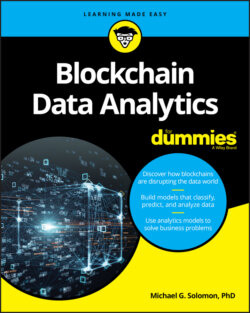Читать книгу Blockchain Data Analytics For Dummies - Michael G. Solomon - Страница 80
Associating real-world meaning to events
ОглавлениеAlthough transaction data can reveal what a client requested and what value was transferred, it doesn’t always provide many details of how the transaction played out. In other words, transaction data doesn’t provide more than summary information. If you want to explore details of what happened during a transaction, you’ll have to look elsewhere.
Because smart contract code can include complex calculations and data, it's often beneficial, and sometimes necessary, to store messages and data at points within the transaction. Most complex business transactions involve multiple steps, and mirroring real-world processes in code makes sense. For example, if you want to import wood from a foreign country to manufacture furniture, you’d follow a general sequence of steps:
1 The importer requests the product from the exporter.
2 The importer applies for a letter of credit from a local bank on behalf of the exporter.
3 The importer’s bank issues a letter of credit and sends it to the exporter’s bank.
4 The exporter ships the product.
5 Based on the terms of the letter of credit, the exporter may receive partial payment while the product is in transit. If partial payment is executed, the exporter’s bank claims the payment due and the importer’s bank transfers the specified payment.
6 When the importer receives the product, the importer notifies the bank and the importer’s bank transfers the remaining funds to the exporter’s bank.
Believe it or not, this process is simplified! I didn’t even touch on export licenses or bills of lading. Even with this simple scenario, you can see that the process has many steps. In a real application, some of these steps might occur at different times and some might occur at the same time (such as in Step 5). It would be helpful if the blockchain stored status information about how the transaction was carried out, as opposed to storing just the amount transferred from one account to another.
Event logs provide that functionality. No events occur by default; smart contract programmers must request each one. Most smart contract code includes at least minimal event invocations. A best practice when developing a smart contract is to invoke an event any time a package of work of interest to the application’s user is completed. That description of when to use events is a loose one and open to interpretation.
Knowing how the smart contract code that will supply data for your analytics projects works is important. In Chapters 5 and 6, you learn how to get smart contract source code and how to use it to build your data acquisition plan. But until then, remember that analyzing data in a blockchain environment requires familiarity with far more than just blockchain data.
